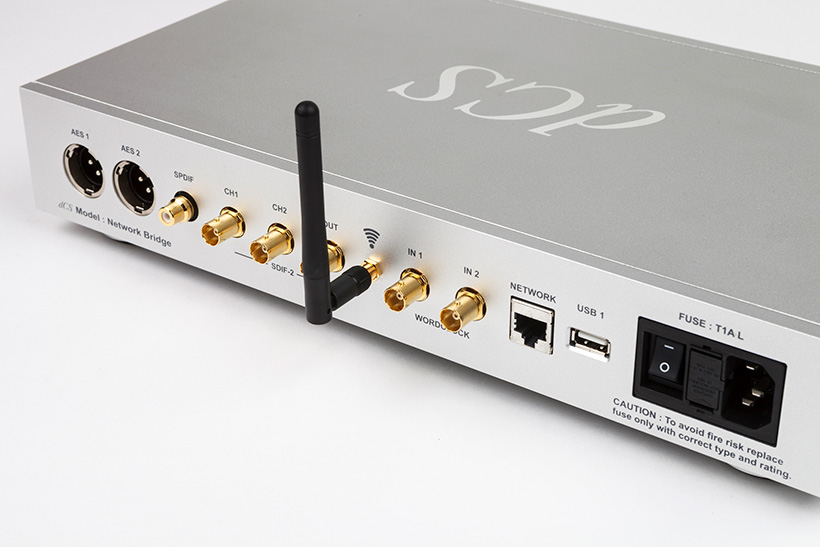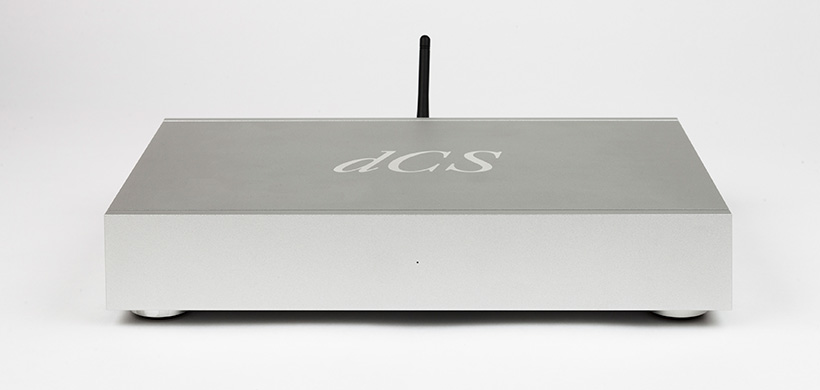DCS Network Bridge | The Ear
Semantics are particularly problematic in the niche within a niche that is ‘serious’ hi-fi. The word streamer is a classic example, is it something that delivers music from cloud based services such as Spotify or Tidal, or does it deliver music that you have stored on a hard drive on your network. Furthermore does it have a DAC onboard or does it need to be used with a separate DAC, assuming you know what a DAC is, but the fact that you are reading this site indicates that you are an intelligent connoisseur and thus you do. dCS makes products from both the latter categories: a DAC with an onboard streamer called Bartok and a DAC-less streamer called Network Bridge. Both will stream music from the cloud and from your library, pretty well all streamers do, but the Network Bridge is less than a third of the price of the Bartok and is the most affordable component that dCS makes by quite a long chalk.

I quite like the name Network Bridge, it makes sense. This device connects by ethernet to the local network and provides a bridge between streaming services and locally stored music files to your system. It only has digital in- and outputs so a DAC is essential but that digital to analogue converter can be a standalone unit or part of an amplifier, a feature that is increasingly common. Albeit not quite so common among the amplifiers and preamplifiers in the relevant price range. Its array of digital outputs is typically dCS and biased toward their approach to sending a digital signal over dual links. The only standard outputs are coaxial SPDIF and two AES/EBU outputs on XLR sockets, there is controversially no USB option. The twin AES outputs can be combined to double the potential sample rate that can be transferred from 192kHz to 384kHz (DSD64 to DSD128 DoP), there is also a pair of BNC connectors that produce an SDIF output (an older standard that’s still popular in Japan) where each channel is sent separately but this has a 96kHz maximum sample rate. Connections are also provided for a word clock which ties the clocking of bridge and DAC together in order to minimise jitter.
The front of the Network Bridge is notably devoid of controls or displays, a single blue LED indicating power on status, and given that this device can be controlled entirely from a tablet buttons are not really necessary. A display provides a degree of confirmation that what the control app says is happening is happening but it’s not far from essential, what can be useful is a play/pause button so that the unit can be stopped quickly if the iPad or similar isn’t to hand. I use this function on other streamers quite often.

The make or break factor with streamers is the control app, almost regardless of how good they sound if the app is bit flaky you don’t want to use them. dCS clearly appreciate this because their Mosaic app proved rock steady for the duration of the review, that said it does have a foible when it comes to UPnP servers from Innuos, which is that it won’t play tracks in the correct order but reverts to an alphabetical order. With a Melco server this isn’t the case and the tracks play in the expected order, the same is true of albums on Tidal and presumably Deezer and Spotify which are native to Mosaic. The other minor irritation is that there is no alphabetical list to quickly find a certain artist or album, if you want ZZ Top you just have to scroll down manually but this is also dependent on the server software. The other side of this coin is that Mosaic doesn’t need to be told to read a connected library, it does it automatically and pretty quickly too. Equally useful is that when you add a title to that library it makes it available pretty much immediately, other systems can require a rescan to find new albums.
The Network Bridge is Roon ready however and I found myself using this for at least half of the time spent listening. The DAC of choice at present is iFi’s Pro iDSD which I generally connect via USB but in the absence of that option switched to an Atlas Mavros coax cable which proved to be something of a revelation. I’ve made USB to coax comparisons in the past and came down in favour of the detailed presentation of the former but this experience made me go back and do it again and come to a different conclusion. Which is that coax is rather more musically satisfying and more than sufficiently detailed, it’s a trade off as ever but musical communication is where digital systems are the most challenged and coax does seem to help. The inbound connection to the network was via AudioQuest Ethernet direct from the server.

Sound quality
The first thing that struck me when firing up the Network Bridge was just how smooth and clean it was after the Auralic Aries G1 that normally does this job in my system, but this impression didn’t last long and like any comparison is only shows one aspect of the streamer’s character. It is also a positive quality so long as detail and timing cues are not being masked by the finesse, over time it became clear that is certainly not the case. It’s more like the extra information fills in the gaps and makes for a richer sonic picture, and thanks no doubt to a very low noise floor it delivers a lot of low level detail that does wonders for all manner of music. Ryley Walker’s ‘Halfwit in me’ was delivered with considerable poise and a lovely vibrant acoustic guitar over a rhythm section that was clearly in sync; interplay between musicians is particularly well rendered and very engaging.
I also like the way you can hear low bass coming from the stage PA on Dave Holland’s live solo ‘Veil of Tears’ (Live at the 2007 Monterey Jazz Festival), the double bass playing is spectacular and encourages extra level, and here the absence of graine in the dCS’s leading edges really scores because the sound doesn’t harden up or become forward, it just gets more real. A more recent ECM release, Jack de Johnette’s In Movement, was also fabulous with lots of air around the cymbals and plenty of fine detail presented in a musically compelling fashion, it brings out the tension between the players on the title track, an effect underpinned by a subtle repeating beep in the background. Mark Hollis’ voice on Spirit of Eden was also particularly effective thanks to the contrast with the low end growl of the backing and the abrupt crash of the chorus, which was one of those occasions when the volume slider on the Mosaic app proved very useful. I wouldn’t recommend you use this as a general volume control however as like all of its kind it does undermine sound quality quite significantly.
The less polished recording that is ‘The way young lovers do’ (Astral Weeks) worked well too, with good resolution of the many instruments and none of the treble brashness that can mar the experience of this seminal work. The dCS doesn’t have quite as much musical drive as some streamers but makes up for it with an effortless yet nuanced delivery that’s very easy to enjoy. Especially with Alfred Brendell playing Beethoven piano sonatas where the brilliance of the composition and the player are left in no doubt whatsoever. I tried this with coax and XLR cables between streamer and DAC but should say that it wasn’t a dedicated digital AES cable but one half of an analogue pair so not totally indicative. The result suggested no advantage to the XLR so I stuck with the ‘digital’ cable. I did compare the Atlas to a Townshend coax and found in favour of the Atlas which sounded a little more polished, especially when playing another less than smooth recording in the Grateful Dead’s Europe ’72 version of ‘Cumberland Blues’.

While the dCS was in the system a new preamp in the form of a Townshend Allegri Reference turned up, it shares the streamer’s refined, clean style of presentation, so I was a little concerned that the sound would become too smooth and polished. I needn’t have worried, in this instances two plusses did not make a minus, quite the opposite in fact. The extra transparency provided by the Allegri Reference meant more of the dCS’s qualities to shine through, allowing me to really enjoy a wide range of material including James Blake’s heart rending ‘Retrograde’ and Amandine Beyer’s beautiful solo violin, the latter placed in a precise reverberant field and revealing the feeling she puts into the performance to full effect. I also began to notice how much decay could be heard on acoustic instruments, particularly pianos, and the contrast between the pace of one track and another. Jean Efflam Bavouzet’s Haydn piano sonatas seem almost impossibly fast whilst Javier Perianes’ playing of Manuel Blasco de Nebra’s works was so restrained it’s uncanny. And that’s before discovering the solidity of bass offered by Kraftwerk’s live version of ‘Radioactivity’ (Minimum Maximum) which gets properly scary on big ATC SCM150A actives.
The dCS Network Bridge is a sophisticated and polished streamer that initially seems a bit too smooth but soon makes it clear that it’s just very good at reflecting the nature of each recording. It makes me realise that I should really pay a bit more attention to dCS which is one of only a handful of truly high end British brands, it would also be very interesting to hear their preferred twin AES connection from this streamer, it would undoubtedly produce considerable benefits. For now however the Network Bridge has really impressed me, especially given the price that dCS have managed to achieve for what is a superbly built and finished piece of kit.















![Toni Kroos là ai? [ sự thật về tiểu sử đầy đủ Toni Kroos ]](https://evbn.org/wp-content/uploads/New-Project-6635-1671934592.jpg)


